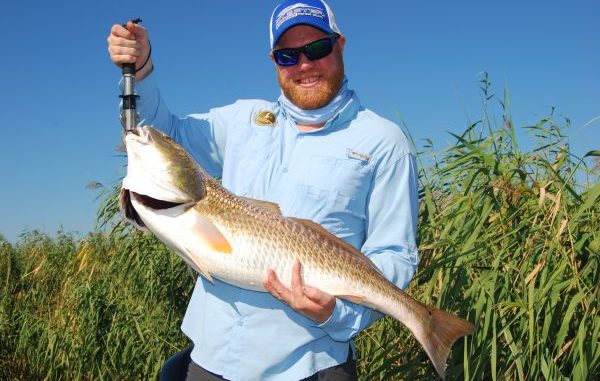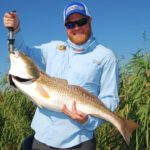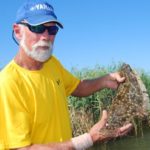
‘Find the pattern’ to catch big reds along the edges of Blind Bay, fisherman says
As angler Hal Schramm surveyed the roseau cane blowing gently in the breeze along the outer edges of Blind Bay Monday morning, he started fishing – but not just for bull reds lurking near the banks.
Schramm, 65, of Starkville, Miss., was observing and making mental notes of both his and his crew’s efforts on each throw.
For instance, whether casts right up against the cane produced results, or if working a spinnerbait or a chatterbait away from the bank proved more effective. Or if the black-and-chartreuse grub was catching the bull reds’ attention, or if a Beetle Spin was working better.
“In fishing there’s so often a pattern, which might even have a sub-pattern or two,” Schramm said. “If you’re going to find that pattern, you’re going to catch a whole lot more fish.”
The morning got off to a promising start when crew member Land Tawney hauled in a nice 20-pounder near the first point Schramm stopped to fish on the eastern edge of the bay, located just south of Pass A Loutre about 30 miles from Cypress Cove Marina in Venice.
“Welcome to bull red land,” Schramm said, as he used the trolling motor to pursue the bull red and eventually net it after about a 10-minute fight.
Tawney, the executive director of Backcountry Hunters and Anglers in Missoula, Mont., caught another couple of nice reds along the bank of solid cane, then reeled in another 25-pounder a few hours later fishing off a point along the northern edge of Blind Bay.
He went on to catch seven nice redfish and a couple of speckled trout Monday as Schramm worked edges, points, pockets and cuts with his 21-foot Ranger.
“Pulling those big bull reds out of that small water is a lot of fun,” Tawney said. “I’ve caught more before, but the quality and number of these fish makes this one of my best days ever down in Louisiana.”
Tawney and Schramm were in Venice for Marsh Madness, an annual four-day event held for fishing industry media from across the country.
After a full day on the water, Schramm talked about what he saw condition-wise at Blind Bay.
“We had two patterns today,” said Schramm, a research fisheries biologist with the U.S. Geological Survey at Mississippi State University. “Where we started out close to a point and a good wall of cane, you could get a cast right to the main edge of that marsh and get a fish.
“Then late in the afternoon, near the back of the bay, they were in areas where there was nice clumps of good healthy cane and that was what was working. That area gave us about five or six fish.”
A gold spinnerbait with a split-tail beetle is Schramm’s favorite go-to bait in Blind Bay, simply because he feels it is the most effective.
“It’s the least sexy bait in the boat. It doesn’t do anything, it doesn’t wiggle,” he said. “It just catches fish.”
On days with murky water, he favors black or dark-colored soft plastics on the spinnerbait, while in clearer, greener conditions he favors reds or browns.
The bottom line, Schramm says, is to maximize every cast by trying to replicate the conditions that produce fish.
“You only know what the biting fish do,” he said. “Lots of times, whether they were there and not biting, you just don’t know.”




